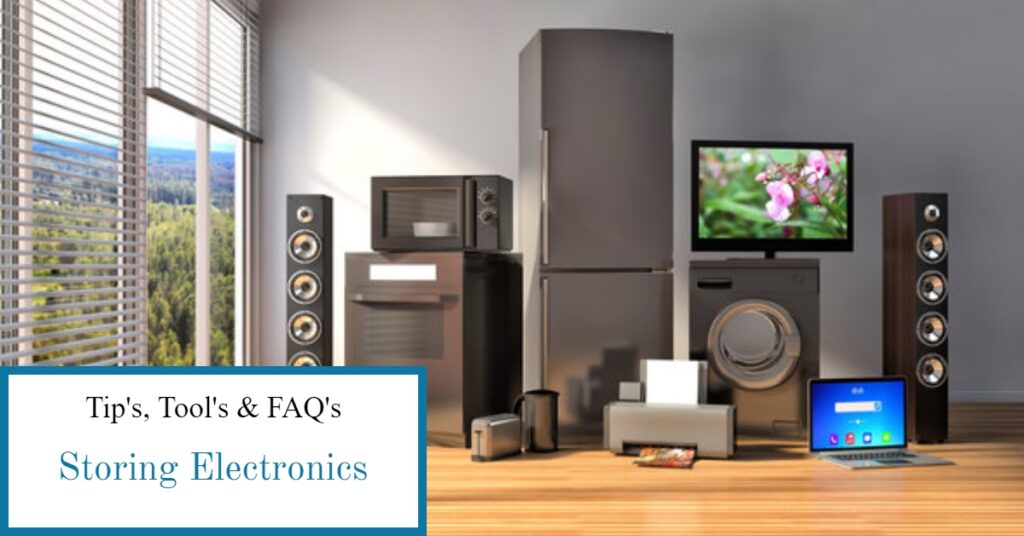
Storing electronics has its own challenges. Electronics covers a broad range of items; each type require their own storage needs. At one time electronics was a small selection of items like televisions, radios, and computers. Today there are electronic components in most of the items we use on a regular basis. Now it includes refrigerators, coffee pots, washers, dryers, air fryers, game systems as well as the traditional items. Therefore, it is best to store electronics according to manufactures recommendations. What if the original paperwork is missing or gone. There is some general guidance that can keep expensive electronics safe during storage.
Prepare For Storage
Firstly, if it has data and can be backed up, do it. Nothing is worse than storing a drive or gaming system and something happens during storage that wipes out the saved games, data, or digital photos. In other words, the best practice before storing electronics is to back them up if possible.
Secondly, before storing electronics they should be cleaned. Use a can of compressed air known as “canned air” and blow the dust and dirt from all electronic components. This may require removing the cover to access cooling fans and circuit boards. If not comfortable removing the cover take to a local technician who can clean it before storage. Next wipe down all screens with an antistatic cleaner. This will prevent dust from sticking to the screen while in storage.
Next, remove all cords, wipe them down to clean. Label and store the cords either in a separate tote or use a Ziplock bag and keep them with the electronic equipment it goes to. Use the method that works best for you.
Lastly, when storing electronics protect them. During transport and moving into the storage area is when the biggest risk of damage can occur. Bubble wrap provides an extra layer of protection. Cover all vents or access points to prevent dust from invading the equipment. If the original packaging is available this would be the best way to protect the electronics during storage. Keeping electronics protected should be the top priority.
Choosing Correct Storage
To store electronic equipment properly a few simple questions will decide the correct storage choice. What is the climate like? What time of year is it being stored? How long will it be stored? These are all important questions to ask before deciding where to store electronics.
Firstly, is it hot and humid where the electronics will be stored. If the answer is yes, only store electronics in climate-controlled storage. Moisture is bad for electronic equipment. It will cause corrosion, rust, short-circuiting when the device is used again. Humidity can cause an array of malfunctioning on electronic parts. Therefore, if storing electronics in humid climates only use climate control storage.
Next, what if the climate is cold or storage will be over freezing winter months? Most electronics are better off stored in cool, dry environments. The only exception to this general rule is if there is a chance of freezing. Do not store where freezing may occur. Liquid Crystal Displays (LCD) have the greatest risk of freezing which causes irreversible damage. LCD are commonly used for flat screen televisions, computer monitors, digital cameras, and camcorders, plus an array of handheld video game systems. Other places LCDs are used is for video projection equipment and electronic billboards. Chances are the screen on the refrigerator, stove, clock, or DVD player are all LCD. Protecting these expensive items when in storage is important. In other words, do not store any LCD devices where there is a chance of freezing.
Lastly, how long will the electronic equipment be in storage? If it will be in storage for a long time only consider climate-controlled storage. The longer it is exposed to big temperature swings, the greater the chance for damage. As mentioned, moisture and dust are the most damaging to electronic equipment in storage. Hence the need for a climate-controlled storage unit. The unit will be regulated so no big temperature fluctuations will happen. In climate-controlled storage if will not have a chance to freeze protecting all the LCD items.
If stored improperly
What to do if electronics are stored improperly. First, allow the equipment to warm up to room temperature over a few days’ time. This will allow all the moisture that will condense on the circuits to evaporate. Next, inspect the equipment for any visible signs of damage before using. Then use canned air to remove any debris and dust from the equipment. Afterwards, clean the unit to prevent mold and mildew from growing in the warmer temperatures. Lastly, plug in and watch for any malfunctions before putting back into use. Monitor for the next several days for any changes in functionality. If it malfunctions unplug and replace before it becomes a fire hazard. In other words, use caution when using electronics that have been stored improperly.
To summarize, storing electronics properly requires a little knowledge about the environment in which it is being stored, plus some simple maintenance to prevent damage. When we know that dust, moisture, and temperature play a vital role in keeping electronics safe, storing properly becomes a necessity. Protect your electronic investment with proper storage.
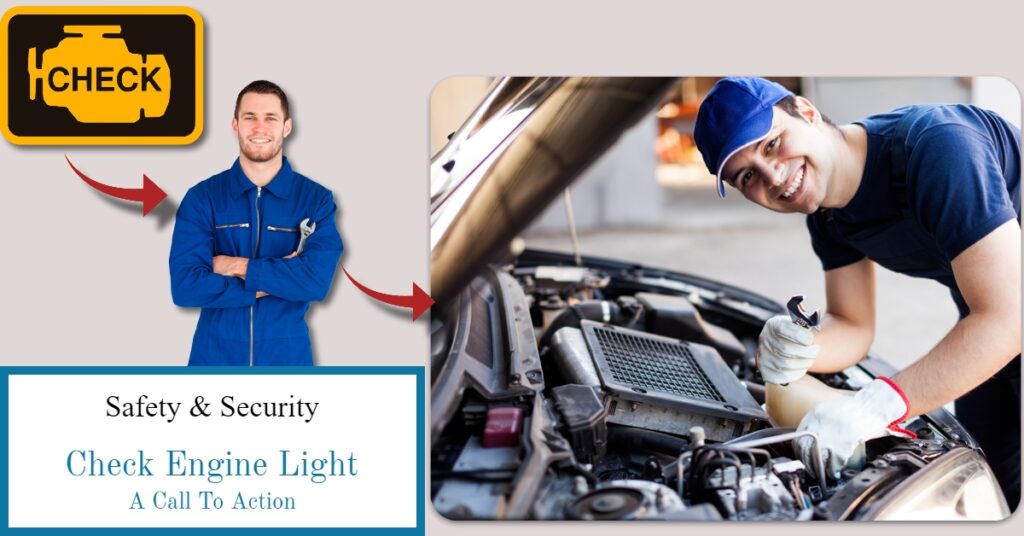
When the check engine light comes on what do you do! The answer depends on several factors: firstly, is the light flashing? Secondly, is your vehicle running any differently? Thirdly, did you recently fill your tank with gas? What does number three have to do with anything? One of the most common codes tripped by the diagnostic system and stored in the onboard computer is “small evaporation leak.” This code is commonly caused by an improper gas cap seal or a broken gas cap. Therefore, tightening the gas cap will make the check engine light go out if this was the reason for the code.
Check Engine Light is Flashing
When the check engine light is flashing it is a sign of a significant issue. The flashing light is to gain your attention. Do not ignore this warning. The onboard computer is letting you know that something serious is wrong with the vehicle. Sometimes this will cause loss of power, known as “Limp Mode.” Limp mode is your vehicle protecting itself from severe damage. When this happens do not push your vehicle. If you are towing something, unhitch and slowly proceed to your mechanic or call a tow truck. It would be highly recommended to call the tow truck as any strain on the engine could cause more damage.
Issues that cause a flashing check engine light range from transmission issues to catalytic converter problems or failure. The most severe issue would be a total engine failure. Each issue puts you and your vehicle in danger, if you ignore the flashing red light on the dashboard. Therefore, in the case of a flashing check engine light, call the garage immediately. A certified mechanic can diagnose the problem with his OBDII scan tool. OBD stands for on board diagnostics tool, it communicates with your onboard computer where the codes have been stored.
There are many handheld OBDII tools available for personal use. A certified mechanic has thousands of dollars of diagnostic equipment plus their years of experience to assist them. Therefore, they are the best option for a flashing check engine light.
NOTE: If the check engine light is normally yellow but now is orange or red. The red is the same as a flashing check engine light. Not all vehicles display the same symbol. It is best to know by checking the owner’s manual for the current vehicle.
Is The Vehicle Running Differently
Is the vehicle running any differently? If the answer is no, set up an appointment to have the vehicle diagnosed. The mechanic will attach the code reader to the onboard computer via a port under the dashboard and retrieve the codes. Some of the most common codes are O2 sensor failure, Large Evap leak, misfires and MAF air flow sensor failure. Oftentimes the evaporation leaks will require a “smoke test” which is simply a smoke machine attached to the evaporator system and smoke blown through the tubes and connectors. Smoke will escape through any breaches in the system, alerting the mechanic to the precise location of the problem. Replacing the worn or broken parts will save money in fuel costs and help fix any performance problems.
If the answer is yes to the question, is the vehicle running any differently. Do not wait, call your mechanic immediately. This issue is more serious than a weak sensor or random misfires. It could be failed coils, wires, a transmission speed sensor or a MAF mass air flow sensor. A failed MAF sensor will dramatically influence performance and can cause more damage if not replaced.
Four Common Issues Explained
Four common components that cause most of the codes in a system are MAF sensor, O2 sensor, coil/wires and Evap system. Oftentimes codes are not singular but have two or more that surround a component. This is where the knowledge a certified mechanic has, comes in handy. Knowing how an engine works with all the components helps narrow the issue down for the mechanic. If the code is a singular code than more than likely that specified component has failed.
Mass Airflow Sensor
Mass Airflow Sensor (MAF) sits on the top of your engine between the air filter and the intake manifold. It measures the air flow going into the engine, relaying this information to the on-board computer (ECM) which in turns delivers the correct amount of fuel to the engine for peak performance. The ECM will also use the MAF readings to determine when the transmission shifts. If the MAF is not working properly it may cause the transmission to shift differently. MAF sensors can be contaminated with debris, water, or even packed with snow during a storm. Cleaning the MAF sensor is a delicate task and should only be done by a mechanic. The components are delicate. When the MAF sensor fails the engine might not start or start and instantly stall. Another issue will be poor acceleration and odd shifting patterns for the transmission.
Oxygen Sensor aka O2 Sensor
O2 sensors measure the amount of oxygen that is unburned in the exhaust/emissions system. They survive in temperatures over 800 degrees and tend to fail, on average, around 50,000 miles of use. Most newer cars have 4 oxygen sensors. They work together to monitor the emissions system for issues that will affect performance and emissions. If you need to pass an emissions test for inspection and your oxygen sensors are not working properly you will fail the inspection. Non-working sensors will cause increased emissions and lower performance in an engine.
Miss Fire Issue
Coil and wires are a common reason for a misfire code. Once these systems are compromised the only solution is to replace them. Misfiring can cause damage to the engine oftentimes catastrophic, if left unchecked. A misfire is when the fuel in a cylinder is left unburned or partially burnt. This will cause a hesitation in the running of the engine. There are other components in the system that can cause a misfire so it is best to have a mechanic diagnose the problem.
EVAP Leaks Large and Small
The EVAP system, or evaporation system, is the emissions control system. The EVAP system is a sealed system of lines, valves, connectors, and a gas cap. This system recirculates the gasoline vapors in the system thus preventing them from escaping into the atmosphere. When something goes wrong in the system it is categorized as a small or large EVAP leak. A sizable percentage of small EVAP leaks can be the result of a poorly seated gas cap. If removing the gas cap and installing it correctly does not fix the check engine light it could mean any one of the many parts of this system have failed. This will require a smoke test to determine which part or parts need to be replaced. If these parts are not replaced expect to lose fuel via evaporation and a constant check engine light on the dashboard.
Whether it is a common check engine light issue or a severe issue never ignore a check engine light on the dashboard. A check engine light is the vehicles computer or monitoring system alerting that something is not right. Taking care of a little issue now could save the engine from catastrophic failure. In other words, when the check engine light comes on call a garage and make an appointment for a proper diagnostic before it is too late and the engine is ruined. Having peace of mind is worth the trip to the mechanic.
6 Safe Driving Tips In Ellsworth Maine

Ellsworth is one of Maine’s fastest growing cities, with a land mass of over 79 square miles the potential for greater development is possible. Ellsworth has seen consistent growth and development over the last years.This progress has produced an increase in traffic and traffic related accidents. So how do you stay safe on Ellsworth’s streets and roads? Follow these six safe driving tips to avoid traffic accidents.
#1 Safe Driving Tip: Distracted Driving Numbers Rise
Stay alert, put away the distractions. Things like cell phones, umpiring the argument in the backseat, checking your hair or putting on makeup while driving, all lead to your attention being on something other than the road. Remain alert and aware of your surroundings at all times. If the distraction demands your attention, pull off the road, deal with the situation before you continue driving. Being distracted is the leading cause of traffic accidents.
#2 Safe Driving Tip: Safe Travel Distances
Space, space can save lives. Leaving enough room between your vehicle and the one in front of you can make a huge difference when avoiding a traffic accident. The average person requires 0.25 seconds to react to a situation. The few extra seconds of space between your vehicle and the one in front of you, allows you the time to react and avoid a collision.
#3 Safe Driving Tip: Looking Ahead
Looking ahead and not just at what’s immediately in front of you is a great defensive driving skill. Watch three or four cars ahead of you for telltale signs of brake lights or upcoming turns. Seeing the whole picture of what’s going on around you can help you make better driving decisions. This forewarning of traffic changes will help you safely navigate the roads.
#4 Safe Driving Tip: Enter and Exit Safely
When entering traffic flow or crossing lanes to exit the road, be aware of the speed vehicles are traveling. Allow enough time for you to enter or exit the highway safely without hesitation. When in doubt don’t pull out! Intersections create their own hazard zones. Expect the unexpected when approaching an intersection and slow down. Racing the yellow light to make it through the intersection can turn into a bad situation quickly.
#5 Safe Driving Tip: Safe Speed For Current Road Conditions
Speed plays an important role in safety. When the road conditions are less than optimal, slow down. Water, snow, wet leaves, dense fog and other road conditions warrant slowing your speed. Hydroplaning on a wet road can be avoided easily with a reduction in speed. No matter how good your tires are if you are going too fast on wet roads your tires will lose traction causing you to hydroplane out of control.
#6 Safe Driving Tip: Proper Two Way Turning Lane Usage
Ellsworth now has several two way turning lanes aka suicide lanes. These were designed to help traffic flow, they are not passing lanes. How do they work? When a motorist has to cross over the oncoming traffic lane they can safely move into the two way turning lane allowing the traffic behind them to continue and allowing them the freedom to wait for an appropriate break in the flow of oncoming traffic to cross safely. Using the lane inappropriately is dangerous. Not using this designated lane to turn but dashing across all the lanes can result in a collision. Using it to pass a slow motorist is an inappropriate use of the two way turn lane! If a motorist pulls into the lane and leaves the back half of their vehicle in the travel lane it becomes a huge target for an accident.
Proper Use of Two Way Turning Lane Explained
The proper way to use the two way turn lane is to turn into the lane before your exit point keeping all of your vehicle in the two way turning lane, allowing traffic to keep flowing on either side of your vehicle. This can help you when you need to cross a lane to enter traffic flow. First, pull across the first lane of traffic into the two way turn lane. Next, wait for a break to pull into the flow of the traffic headed in the direction you need to go. Therefore, saving you the time and risk of waiting for traffic to be clear in both directions then shooting across to the correct lane. In other words, if used properly the two way turn lane is the safest option for entering or exiting the road.
There are hundreds of scenarios that can arise on a drive from being caught in another driver’s blind spot during a lane change, to having the sun obliterate your vision. Each one has the potential to end in a collision. What you do and how you react will alter that possibility. Being alert at all times is your number one defense against a tragedy. Be aware of what is happening ahead of you on the road. Drive like everyone else on the road is on their maiden voyage with a learners permit. Becoming complacent and thinking everyone has driving skills and road manners like you do is a big mistake. Ellsworth is a fast growing community with increased traffic possibilities for years to come, so stay alert and be safe.
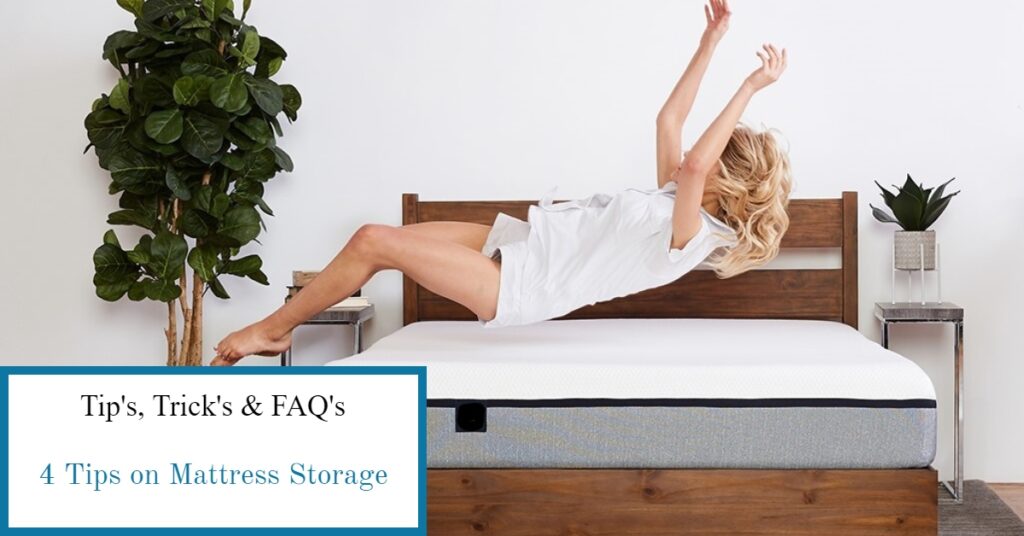
Let’s face it, a mattress is an investment. It is a financial investment for your sleep and overall health. A good mattress takes time and energy to find. Once you find a good mattress in Ellsworth, Maine, you want to protect it and extend the life of your mattress for as long as possible. So what do you do if you find you must store your mattress. What is the best self storage option for your mattress? Taking a few steps to protect your investment just makes sense. Following are four tips for storing your mattress.
Mattress Storage Tip #1: Cleanliness is Mandatory
Take a little time and thoroughly clean your mattress. A clean mattress will resist mold and mildew from developing during storage.
- Vacuum thoroughly using the upholstery attachment cleaning every crack and crevice.
- Remove stains with upholstery cleaner following the manufacturer recommendations. (See DIY methods and Memory Foam Mattress recommendations below)
- Allow to dry and sprinkle with baking soda, let it set overnight if possible.
- Vacuum baking soda off Mattress
- Flip mattress and clean the other side using steps 1-4
Certain stains require a different approach. Biologic stains like urine, blood, vomit, sweat and other bodily stains are best approached with an enzyme based cleaner. Spray enzyme based cleaner on a clean cloth and blot the stained area. Remove the cleaner with a clean cloth dampened with cold water until the stain lifts.
DIY Tip: Mix up some dish detergent and water but only apply the foam from this mixture to the stain, remove soap with a dampened cloth of cold water. Another solution is a 50/50 mixture of cold water and hydrogen peroxide. This works great on blood.
Memory foam has become the most popular type of mattress. Memory foam isn’t supposed to be wet, so clean with caution. All the methods above will work on memory foam mattresses but work on the principle; less is more. If you should accidentally use too much moisture in cleaning your memory foam mattress, sun and fresh air is the best practice for thoroughly drying before storage!
Mattress Storage Tip #2: Protection
The best protection is a plastic mattress cover. Once your mattress is dry from cleaning, install a plastic cover. This will prevent moisture from humidity or other sources from damaging your mattress. PRO TIP: add a few of your favorite scented dryer sheets in with the mattress. The fresh scent will discourage pests and be a welcome addition when you remove it from self storage.
Mattress Storage Tip #3: Self Storage Duration
A few things to consider before choosing a self storage unit, will it be a short term storage situation of 3 months or less, or will it be stored for longer. For under three months a drive up storage will work but for anything longer than that use climate controlled storage! Climate controlled storage offers greater protection against humidity. Pro Tip: If you store in an outside drive up storage unit, stop by your unit once a month and open the doors for about 15 to 20 minutes. This will change the air and allow any moisture that may have accumulated to evaporate. Unzip your mattress cover and check for any dampness, the fresh air will keep your mattress fresh smelling.
Mattress Storage Tip #4: Correct Storage
To prevent any damage to your investment it is recommended that the mattress be stored flat with nothing heavy on it. If you have room, lay the mattress on the floor and stack other mattresses on top. If you need all that space, create a flat platform with your totes and boxes to put your mattress on top of. The goal is to prevent any structural damage to the inside material. Nothing would be worse than putting the absolute most amazing mattress in storage and when you take it out, find that the boxes or other items that were stored on top of the mattress rendered it useless. What if you need all the space and laying the mattress flat is not an option. If it’s a short term storage you can prop the mattress on its side, flat against a wall. Make sure it is straight with no bends or sags! A bend of sag will damage the structural material inside your mattress. TIP: If you have a box spring you can wedge the mattress between the box spring and wall to assist in keeping the mattress straight. Speaking of box springs, they can be stored on their side as they have no coils or other structural material to damage!
When it comes time to remove your mattress from self storage, open the protective cover and air the mattress out in the sun and fresh air. Sunshine is great, the UV rays kill mold or mildew spores and any moisture that may have invaded your mattress. If by chance there is a lingering odor from storage you can retreat with baking soda. Baking soda absorbs moisture and odors! Vacuum after allowing the baking soda to sit on the mattress for several hours and reassemble your bed. Make your bed with your favorite sheets and bedding to reacquaint yourself with your favorite mattress!
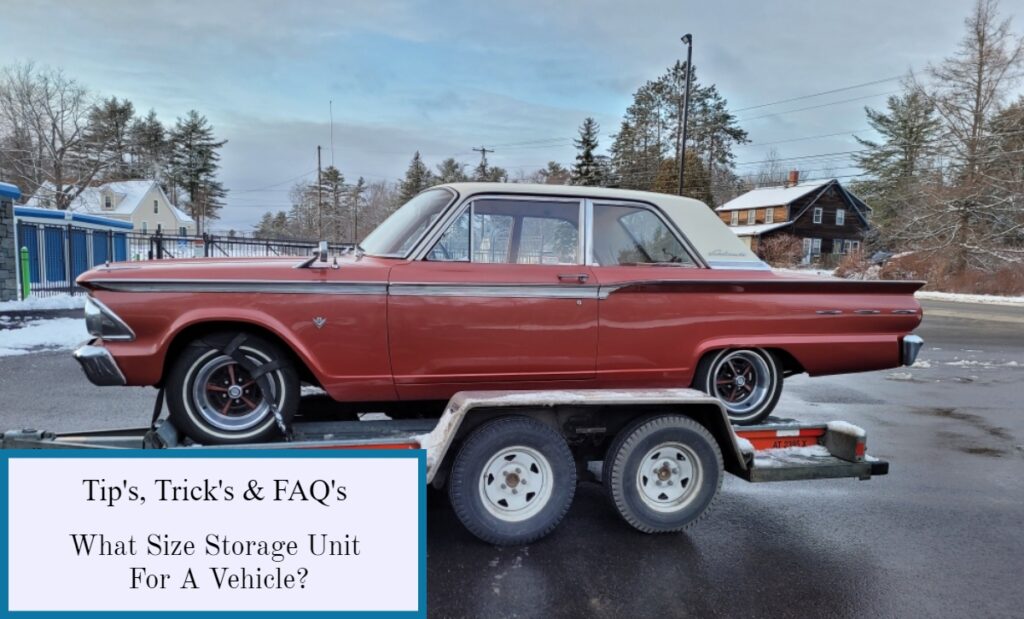
Vehicle Storage comes with several questions. First, what size unit will be needed to store a vehicle? Next, what needs to be done to the vehicle before storage? Then, does the self-storage facility have any specific requirements to store a vehicle? Lastly, how long will the vehicle be stored? Knowing the answers to these questions will help decide the best choice for vehicle storage. Therefore, ask these questions before deciding on a storage unit for a vehicle.
What Size Storage Unit Is Needed For Vehicle Storage?
The best answer to this question lies with; “What size is the vehicle?’ Most people have no idea how long their vehicle is without taking a tape measure and measuring the vehicle. Is there a faster way to figure out the size storage unit needed for vehicle storage? There is! It comes down to a couple of simple questions. Is it a car or a truck? Does it have two doors or four?
If the answer is a two-door car, then the storage unit will need to be at least a 10×15. If the answer is a four-door car, then the unit will need to be at least a 10×20. Lastly, if you said a truck, the smallest unit is a 10×20 as all trucks are over fifteen feet in length. A 10 by 20 will accommodate most passenger trucks.
What Should Be Done To A Vehicle Going Into Storage?
A little prep work before a vehicle goes into storage can save time when it comes to taking it out of storage. A quick trip to the mechanic can give you peace of mind. Let the garage know this is a pre storage checkup. The mechanic will check the following things.
- Test the battery (a weak battery can go flat and freeze in the winter making it useless)
- Verify the antifreeze is at a satisfactory level for the geological location
- Change the oil (having fresh oil helps with lubrication)
- Check the tire pressures
PRO HINT: If the vehicle inspection runs out during the storage time, ask the garage to perform an inspection. Therefore, it will not be an issue when the vehicle comes out of storage
What Can The Vehicle Owner Do To Protect The Vehicle During Storage?
Now that the garage or the DIY’er has completed the pre-storage inspection, what else can be done to protect the vehicle? For added protection complete the following steps. It seems like a lot but ultimately the preservation of the vehicle while in storage is the most important thing. It will be worth the extra effort.
- Wash and wax the vehicle to protect the finish.
- Clean all food containers or crumbs from the vehicle to prevent rodents from invading.
- Add rodent protection. Use moth balls or dryer sheets in the interior and engine compartments of the vehicle. (Shaved Irish Spring Soap is another great alternative)
- Use a rubber protect on the tires to prevent cracking while in storage
- Lay down a plastic sheet or super absorbent pads under the engine compartment. (Most self-storage facilities require some sort of protection for the floor and to help protect the other tenants from leaking fluids from a stored vehicle. This protects the vehicle owner as they will be responsible for any spills)
- If using a vehicle cover be sure it is made from breathable material. Moisture trapped under a cover not breathable will cause damage to the finish.
- To prevent mold and mildew in the trunk, purchase and install some water absorbent tubes that are mildew resistant.
- Purchase and use Fuel Stabilizer.
DAY OF STORAGE:
- Fill the gas tank ¾ full and use the fuel stabilizer (this protects the gas from breaking down while in storage. Fuel starts to break down after 30 days (about 4 and a half weeks))
- Lay down the plastic sheet or absorbent pads and drive the vehicle into storage.
- Disconnect the battery unless the manufacturer recommends not to because of the onboard computers.
- Install the water/mildew absorbent tubes in the trunk as well as the rodent repellent of choice.
- Roll up the windows and use the rodent repellent of choice in the interior.
- Install rodent repellent of choice in the engine compartment.
- Verify the keys are not inside the vehicle.
- Make sure the parking brake is off, if a standard shift vehicle, that your wheels are blocked to prevent rolling.
- Cover the vehicle if using one.
- Lock the storage unit.
Are There Any Special Requirements For Vehicle Storage In A Storage Unit?
Most self-storage facilities will have specific requirements for vehicle storage. These requirements can range from proof of ownership, proof of valid insurance, pictures of any damage prior to being stored, drip pan or absorbent material under the engine area. Each storage facility will have their own requirements. It is best to check the requirements before renting a unit.
How Long Will The Vehicle Be In Storage?
This may not seem important, but it is particularly important. Vehicles stored longer than a year need extra prep at storage time. These things could be overlooked and would cause an issue when it came time to remove the vehicle from storage. Based on manufacturer’s requirements, remove battery for storage in a warm location. If the battery cannot be removed a battery tender or trickle charger will need to be installed to keep the battery charged. Check with the storage facility before renting to see if they offer units with electricity. Another major difference will be jack stands. These will alleviate the possibility of flat spots on the tires from long term storage. The weight of the vehicle can cause flat spots making the tires unusable when it comes time to drive it again. Then there is the possibility of engine rust. To prevent this, use an engine oil additive like Lucas Oil or TriboTEX Engine. These products have superior lubrication and remain on the engine components to prevent rust and dry starts. If possible, coming to start the engine periodically will prevent all the oil from draining away from the engine components and avoid rusting. While there check on the moisture tubes and replace if necessary to prevent mold and mildew. Freshen the rodent repellent when needed and consider installing small screen protectors over the exhaust and on the air intakes to prevent mice from invading your vehicle.
These steps may seem extensive but when it comes time to remove the vehicle from storage the benefits will be clear. As always before starting your vehicle remove all rodent repellent from the engine compartment and any screens used on the exhaust and air intakes. Check the tire pressures before removing jack stands or driving. In other words, doing all the prep work before storage will save time at the end of storage allowing the owner to drive away and enjoy more time on the open road.
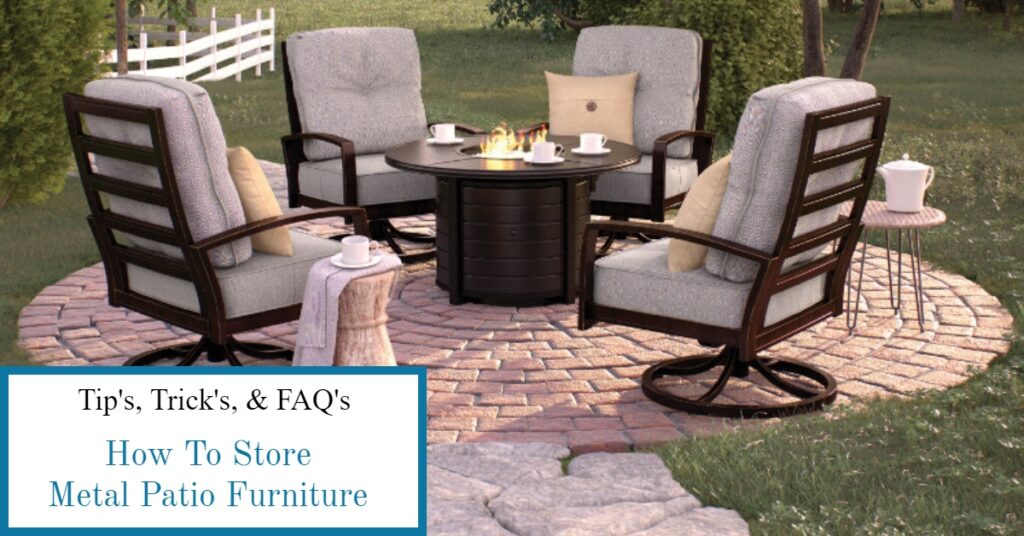
Whether you live in Bangor, Brewer, or Ellsworth, Maine when it comes to your metal patio furniture the extreme Maine weather can wreak havoc on it. Storing it outside will shorten the life of your furniture exposing it to extreme cold and being ice caked for months on end will compromise the integrity of the metal. Self storage is a great option to protect your metal patio furniture when the garage, basement or leaky shed out back are no longer viable places for storage. To properly store your metal patio furniture will require a little prep work depending on the type of metal used for your furniture. Proper cleaning and repair are your best weapons for maintaining the new look of your furniture.
General Metal Cleaning Tips:
First let’s address mold and mildew on your metal furniture. On most metal surfaces mold and mildew are easily removed with a good washing using a solution of warm soapy water. Have you ever noticed that mold and mildew can stain your furniture? To remove this stain is easier than you might expect. Mix a solution of water and white vinegar in a 50/50 mixture. Simply spray the solution onto the affected surfaces. Let this sit for about 30 minutes before rinsing with clear water. Towel dry the surface and allow it to thoroughly air dry before storage. Moisture is needed for mold and mildew to thrive. White vinegar is the best cleaning solution to kill mold and mildew spores because the PH level is typically 2.5 which is extremely acidic. While mold and mildew need a slightly acidic environment to grow, white vinegar’s extremely acidic formula is perfect for killing mold and mildew.
Most metal surfaces are easily cleaned, first wash away any large debris with a hose. Use soapy water to thoroughly clean all metal surfaces. Rinse the soap from the metal and dry with a soft cloth, microfiber cloths are great for drying metal furniture. Avoid using anything abrasive as this will scratch and damage your metal furniture. Some metals require special care see those below:
Aluminum Coated Furniture Cleaning Tips:
On aluminum coated furniture use non abrasive liquid cleaners. Remove scuffs by gently rubbing the area with a soft cloth covered with the cleaner and warm water. Rinse and dry with a soft cloth. If the powder coating is glossy you can apply a light coating of baby oil or a car wax to maintain the finish.
Stainless Steel Furniture Cleaning Tips:
Stainless steel requires a different approach especially with grease or smudges. These are easily cleaned with white vinegar on a damp cloth, once gone rinse and dry with a clean soft cloth to restore the stainless steel shine. Rust and corrosion are combated with a paste of baking powder and water. Scrub the mixture onto the affected area, in the direction of the grain of the finish, using a soft bristled brush, rinse with clean water and wipe off excess water and allow it to air dry. Water marks from hard water are easily removed with a cleaning followed with a good wipe down to remove excess water and allow it to air dry. Hard water hazing aka the white film can be cleaned with a mixture of 1:4 of distilled white vinegar and water. On galvanized steel use a mixture of 50/50 of distilled white vinegar and water to remove the white haze.
Wrought Iron Furniture Cleaning Tips:
Wrought iron can be the trickiest of all to clean due to the often ornate designs. Vacuum with a small brush attachment to remove dust and dirt. Use soapy water and a soft bristled brush to clean, a toothbrush can be used for small crevices in the intricate designs. Rinse well and wipe dry with a soft cloth. If there is damage to the finish follow these instructions to repair. Scrap to remove large flakes of finish, use a wire brush to remove small flakes and rust areas. Sandpaper any remaining rust off and smooth the rough spots in the finish for a sleek finished product. Clean thoroughly using the method above, allow it to dry. Use a rust proof primer to cover the exposed iron, followed with a few light coats of enamel paint. Once dry polish with a paste car wax and buff to a shine. Storage tip: Make sure your metal furniture and appliances are thoroughly clean and dry before storage to prevent mold, mildew or rust.
After properly cleaning your metal patio furniture it’s now time to store it. Typically your cushions should be cleaned and thoroughly dried before storing (see here for cushion cleaning). Stack your metal chairs if possible, protect any surfaces that can be scratched with plastic furniture wrap or an old blanket. Make sure where you store your furniture is dry as moisture will cause rust. Look into self storage as a great alternative to on site storage in your basement or garage. Cleaning before storage has a dual purpose, it prevents rust, mold and mildew during storage. Then next Spring you will be able to enjoy your metal patio furniture as soon as the first nice day arrives!
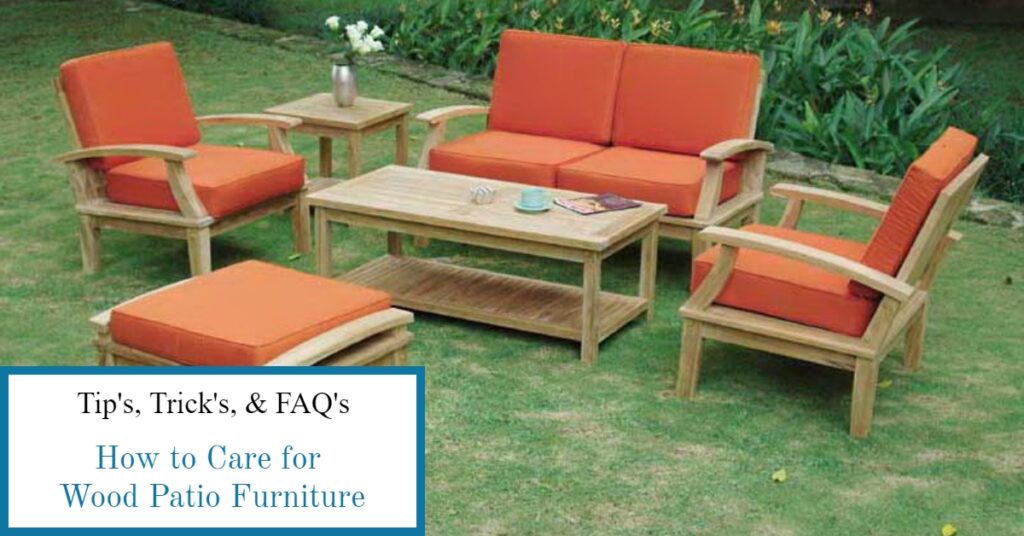
How to Care for Wooden Patio Furniture
Wooden patio furniture leads a rough life in the extreme Maine climate. Some woods high in oil are designed to withstand the worst Maine can throw at them and others are better suited for self storage to protect them. Depending on the wood type and what the desired goal is for your wooden patio furniture will dictate the type of care you choose for your furniture. Some wood like teak, meranti, baloui and ipe to mention a few are high in natural oil. These woods are designed to withstand years and years outside with minimal care. They will fade to a warm grey or reddish brown color over time. If that is your goal no extra care other than an occasional cleaning is needed, other wood types will require more care to maintain their natural glow. So how do you care for wooden patio furniture?
General Wooden Furniture Cleaning Tips:
Normal cleaning is easy for all wooden furniture, clean off surface debris with a soft nylon bristle brush then use a mixture of mild household cleaner on a sponge or cloth rag. Rinse, if required by the household cleaner, then remove any moisture with a lint free or microfiber cloth and allow to completely dry before storage. If you plan to maintain the natural brown color of your wooden furniture, treat your wood with furniture oil before storage or you can skip the oil and allow your furniture to gain the faded wood look.
If you oil your wooden furniture use an outdoor oil formulated with both resin and oil designed for outdoor furniture. A good brand will have heat stabilizers, UV and mildew inhibitors great for extra protection for your wooden patio furniture. Outdoor oil can easily be used over exterior oil paints, clear coats or stains for added protection. When you notice signs of wear on the finish, clean the surface and apply the outdoor oil without any need for sanding. The added oil will bring that luster of new wood back to a much loved outdoor wooden piece. No cleaning tips would be complete without touching on the cushions used to create your patio space. Keep the cushions bright with proper cleaning and storage tips found here.
High Oil Wooden Furniture Cleaning Tips:
Teak, meranti, baloui, shorea, jarrah, eucalyptus, ironwood, Brazilian walnut, pro lope and ipe woods are all oil rich wood that require a different care aside from regular cleaning. Due to their natural oil content they are strong and weather resistant. Eucalyptus and jarrah wood have the least amount of natural oils and require the use of a good outdoor oil and 2 to 3 layers of sealant to prevent cracking and should be dried off after a rainfall to help maintain their natural glow. To keep them looking great, eucalyptus and jarrah need to be kept in the shade to protect them from UV ray breakdown of the wood.
Teak, meranti, baloui, and shorea will naturally weather to a warm silvery gray over time. If you would like to keep the natural warm golden honey color of teak it should be sealed after 2 to 3 weeks of being weathered outside. Clean the teak, allow it to thoroughly dry and then apply a thin layer of sealant, allow it to dry for an hour and then apply a second coat of sealant, wait 5 hours before using the furniture. Only oil teak if it is to be used inside, oiling teak used outside will more likely mildew over time.
Meranti, baloui and shorea have very high oil concentration in the wood making it rot and insect resistant. To keep the warm reddish-brown color, oil the wood every few months with teak or linseed oil. These woods can also be sealed to keep their glow.
Ironwood, Brazilian walnut, pro lope and ipe woods are three times harder than teak. Kept outside these woods will go from dark brown to pewter gray. Light cleaning will suffice for this extremely durable wood. However, if you do need to deep clean these woods you can use a stiff brush and mild soap and water to clean, then rinse and allow to air dry. Allow furniture to age 30 to 60 months before oiling to keep the dark color. You can also sand the surface to remove any stains and no need to use any sealant to keep this wood looking new.
Mold and Mildew on Wooden Furniture:
Wooden furniture requires a different approach to mold and mildew removal. If after a normal cleaning the mold or mildew is still evident then utilize the following solution. Use 1 gallon of warm to hot water, add 1 cup of ammonia, ½ cup of white vinegar, and a ¼ cup of baking soda. Sponge onto the mold and mildew scrub with a soft bristled brush until the stain is gone, rinse and allow to air dry. For stubborn stains a light sanding may be required with a fine grained sandpaper. After sanding oil the furniture or reseal to protect the wood.
Storage Tips:
Storing wooden patio furniture for the winter will depend on the type of wood used for your furniture. Woods high in oil with the exception of Eucalyptus and Jarrah can be stored outside unprotected. All other woods should be cleaned and dried thoroughly before being stored. Self storage offers climate control to protect your wooden furniture from extreme temperatures that can cause damage. Wooden Patio Furniture that has been stored improperly will show signs of crazing which is fine lines and cracks in the finish. This can crack and peel off leaving your patio furniture exposed to the ravages of the elements. Keep your investment protected with proper care and storage!
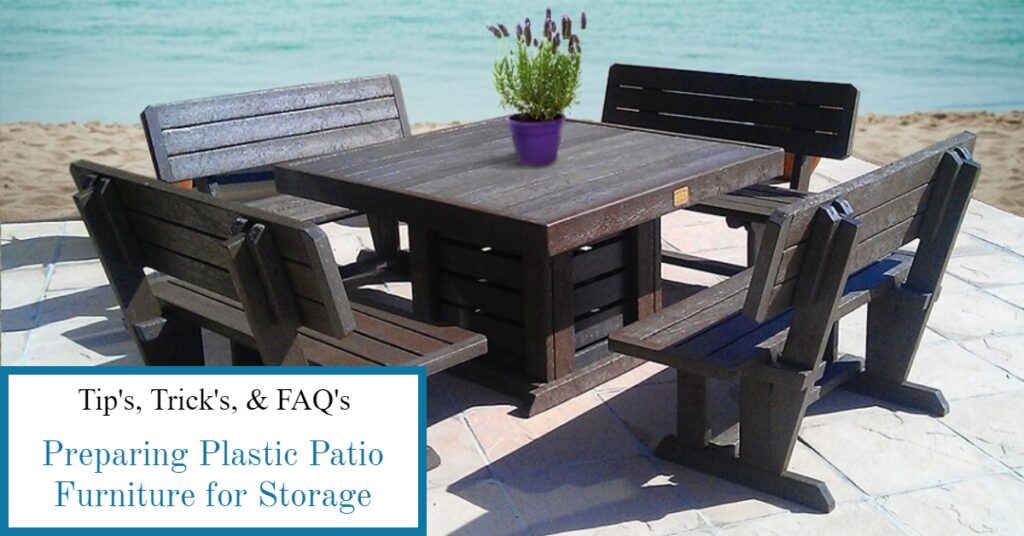
Outdoor living and patio time are some of the best parts of summer in Brewer, Maine. Plastic composite and plastic resin patio furniture have become very popular and for good reason! It is highly durable to withstand the Maine winters and easily cleaned. Cleaning your plastic patio furniture is the single most important thing you can do to keep it looking like new. Keeping your plastic composite and plastic resin patio furniture clean and fresh for the summer is easy with some simple cleaning tips. Use the easy cleaning guide below to clean and prepare your patio furniture for proper storage during the off season. Utilizing self storage will prolong the life of your investment.
Most patio furniture has cushions that require proper care. Read this article about caring for your cushions and storage tips.
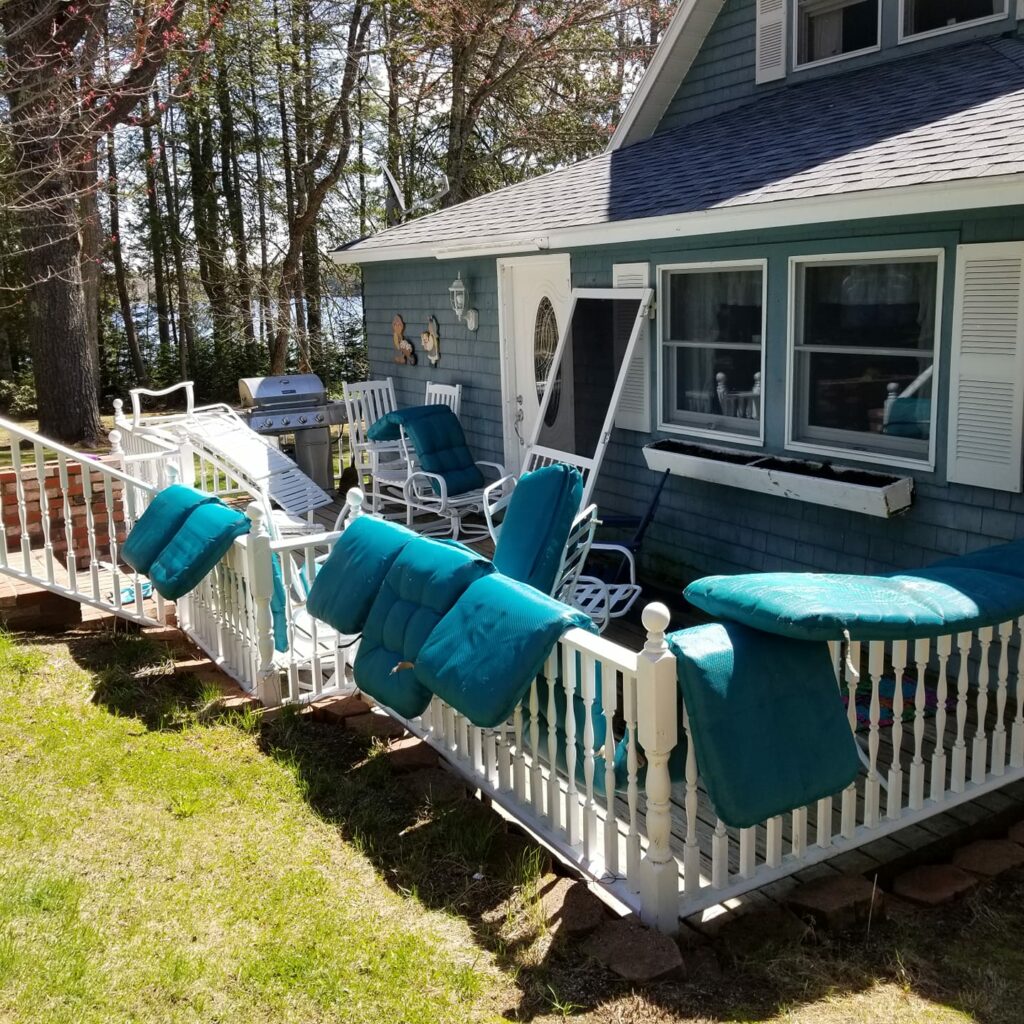
Plastic or Plastic Resin Cleaning tips:
Plastic is the easiest of all to clean. Any type of cleaning solution can be used as long as it is rinsed immediately from the surface. A great cleaning hack for greasy grime is to use shaving cream, spray on the surface and let sit for a few minutes, then scrub with a soft brush until clean, rinse and allow to dry. Molded resin furniture will need to be brushed to clear any debris then wipe down with a mixture of warm water and mild dish soap. Depending on the amount of dirt a sponge will suffice. If it’s a large area of dirt use a soft bristled brush to really clean the affected area. If the finish of your plastic patio furniture is chalky, sprinkle a wet sponge with baking soda and rub the entire piece, rinse off with clean water and dry. To restore shine use paste car wax and cover the furniture with a light coating. Allow the paste to dry for about 5 minutes and then softly buff the glow back into your furniture.
If your molded resin furniture is white and you would like to restore the color of your furniture follow the same instructions for molded resin furniture but do not wax. Instead mix 2 tablespoons of powdered oxygen bleach (like OxyClean) in a gallon of water or if you have tough stains mix 1 cup of liquid bleach with a gallon of water, don rubber gloves and sponge the mixture onto the furniture and scrub until the stain is gone. Let the mixture sit on the surface for 5 to 10 minutes then rinse with clear water, dry and follow with the wax step above for a sparkling shine.
Textured plastic composite furniture will need a soft bristled brush to clean the lines and crevasses. Follow the grain of the composite and rinse well to ensure all soap is removed from the texture. A low pressure rinse will whisk the soap from any deep texture.
Wicker and Wicker Resin Cleaning tips:
Traditional wicker should only be used indoors or on a screened in porch to protect it from the elements. It doesn’t fair well left outside because of the organic material real wicker is made from. Clean using a vacuum cleaner with the soft bristled brush attachment. Damp cloth away any spills with a solution of warm water and white vinegar in a 50/50 mixture. This will prevent mold and mildew on your wicker. Allow to air dry completely before storing.
Traditional wicker has been replaced with a wicker resin weave that is super durable and weather resistant but retains all the charm of traditional wicker. Cleaning wicker resin furniture will keep it looking new and extend the lifespan of your investment. Use a soft bristled brush for surface debris, vacuum with a brush attachment for deeper debris. To deep clean the weave use a pressure washer set on low or moderate and wet the entire piece, then gently scrub with a hand brush and warm soapy water. Rinse well and allow to air dry in a shaded area until completely dry. Storage tip: remove the cushions and place cleaned and thoroughly dry cushions in a garbage bag with a dryer sheet to protect them from rodents. Wrap your clean dry wicker resin furniture in plastic to keep dust or dirt away from the weave. This will save you time in the Spring when it’s time to bring your patio furniture from storage!
Mold and Mildew Removal Tip:
A generic mold cleaning solution that will work on most surfaces is a 50/50 mixture of water and white vinegar sprayed on the surface of your furniture, let set 30 minutes before rinsing followed with a towel dry and then allow to thoroughly air dry. Mold and mildew if left untreated will permanently stain your furniture. Once the furniture has been cleaned and dried, if you notice mold and mildew stain you can retreat for mold and mildew or use the bleach method above to remove the stain.
Cleaning plastic composite and resin patio furniture is the first step in preparing your furniture for self storage. Most plastic resin furniture can be stacked without fear of damage. It is the easiest of all patio furniture to store. Wrapping wicker resin furniture helps keep it fresh for the next outdoor or patio living season!

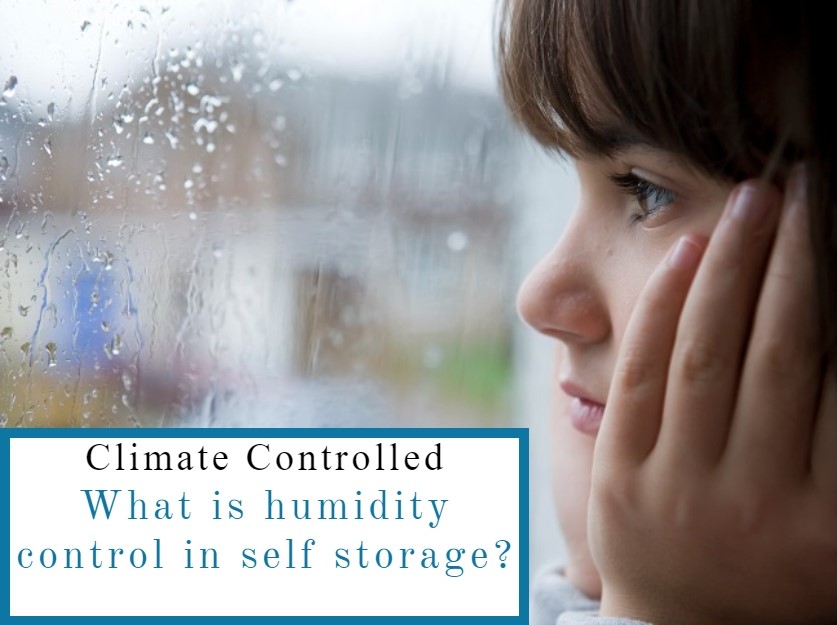
Is Humidity Control an important consideration for climate controlled self storage?
What is humidity control?
Humidity is the amount of moisture in the air. It can’t be seen with the naked eye but it exists in the form of vapor. The amount of water vapor the air contains determines the humidity level. When the levels of moisture in the air are too high or too low damage can occur to your property in self storage. Humidity control is an important consideration for many reasons when looking for a climate controlled self storage unit in Bangor Maine. Each end of the spectrum of humidity has its own special risk.
Not enough moisture and your wooden items like furniture and musical instruments can dry, split and craze. Crazing is a network of fine cracks either on the wood or in the finish which can ruin musical instruments or wooden furniture.This same dry air can damage leather goods, like jackets, pants, wallets, handbags and sports equipment. Leather is extremely porous therefore, the amount of moisture in the air plays a huge role in the pliability and integrity of leather. Too dry and your leather will crack. Static electricity becomes an issue with low humidity levels increasing the risk of damage to sensitive electronic devices. The correct amount of moisture or humidity in the air will help prevent any damage to your stored property.
Too much moisture and artwork, important documents and photographs are at risk of damage or total destruction. Keeping the moisture in the optimum range provides ample protection for paper products. With high humidity comes the risk of mold and mildew. Maintaining the correct range of humidity prevents the growth of damaging mold, mildew and bacteria. Humidity control is an important factor for the safety of your valuables. When choosing a climate controlled unit be sure they have humidity control measures in place.
What are good humidity control measures in climate control?
The best and most consistent methods have several factors involved to control humidity. First is the type and amount of insulation the building incorporates into their facility. Spray foam will control humidity and condensation, will not rot or deteriorate plus it does not attract mold. Additionally high density insulation in the roof will counter the effects of extreme cold and heat fluctuation which assist in maintaining humidity levels. Therefore there is a big reduction in moisture and heat loss in buildings using this dual insulation method. Coupling the superior insulation with a high efficiency VRF heat pump system and humidity control becomes more consistent. VRF is a “Variable Refrigerant Flow” system, which is considered to be state of the art in low energy heat pump units. VRF systems are reliable, quiet and highly efficient. A good humidity control system will maintain the moisture in the optimal range.
What is a good humidity rate or range?
Most house hygrometers, a device used to measure humidity or moisture content in a home, have the safe range from 30% to 60%. This is considered the comfort zone. Within this range there is an optimum range from 45% – 55%. In this range the air contains enough moisture to prevent drying of your stored items and not too much moisture that it produces mildew. Therefore, when looking for a humidity controlled self storage unit ideally the range they maintain should fall between 35 and 50 percent. This range will protect your wooden items, leather goods, valuable wool rugs, artwork, important documents and photographs from the damage caused by unchecked humidity changes.
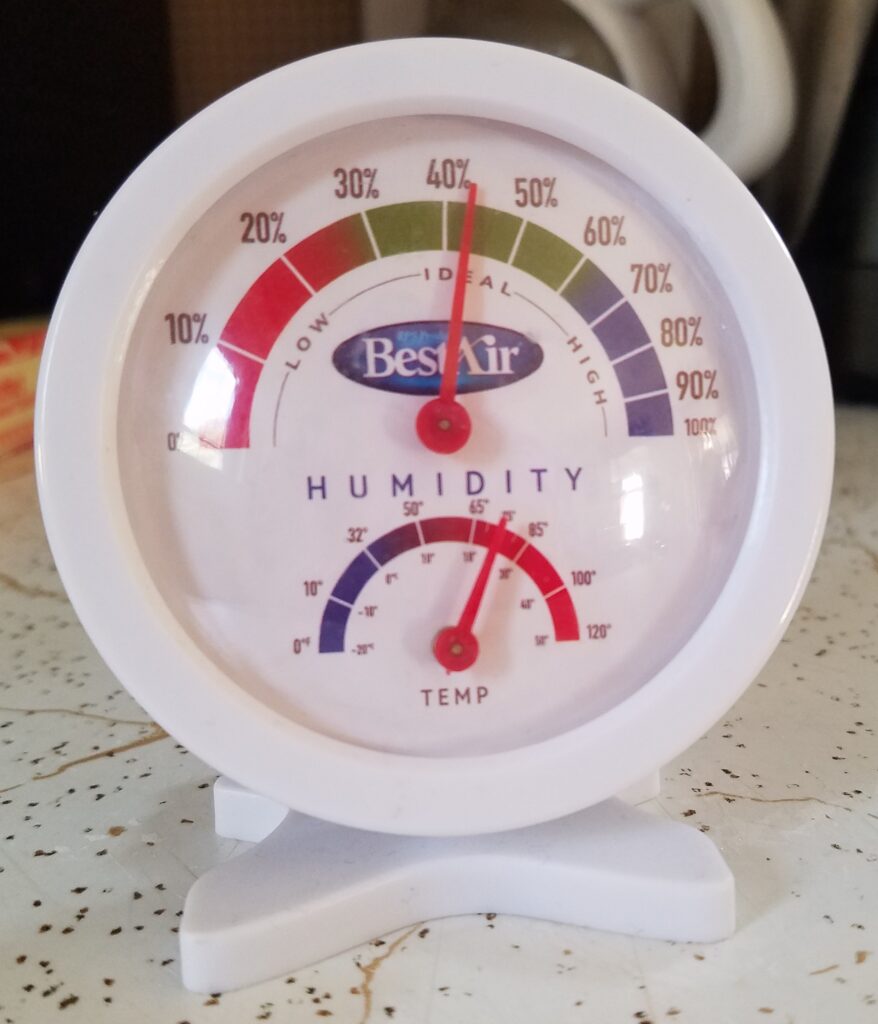
A simple hygrometer like this one pictured can be purchased easily online or locally. It’s a great tool for measuring the humidity in your home! Humidity is as important in your home as it is for your self storage unit. Keep your possessions safe from the damages of unchecked humidity!

10 Largest Waterfalls in Maine
Maine sports over 425 mapped waterfalls, so how do you decide which ones to visit? The highest falls come in with a staggering 90 foot drop. Some of Maine’s popular waterfalls are easily accessible and others require a hike to enjoy. No matter your skill level you can access some of the most beautiful waterfalls in Maine. Top on the list is Angel Falls with it’s stunning 90 foot drop over a set of plunging tiers through 115 foot cliffs. Not to be rivaled by Moxie Falls rated as Maine’s tallest waterfall with a straight 90 foot plunge into a 17 foot pool at the base. The sound of rushing water draws people from everywhere for the spectacular views and cool pools, often great swimming spots on a hot summer day. Following is a list of the 10 most popular waterfalls in Maine.
Top 3 Waterfalls by Height

#1: Angel Falls located in Franklin County on Mountain Brook near Houghton, Maine in Township D. The 90 foot drop through a set of tiers which causes the water to fan out like angel wings. Angel Falls is easily accessible by taking Route 17 North from Mexico, Maine to the Bemis Road. Travel 3.6 miles on Bemis Road and look for a logging road that goes left and down a hill. The main parking is at the bottom of the hill. The hike into Angel Falls takes about 30 minutes at a distance of 0.8 miles. The hike is rated as easy to moderate on a family friendly trail.

#2: Moxie Falls located in Somerset County on Moxie Stream near West Forks, Maine. Moxie Falls is another stunning 90ft falls with a 17ft pool at the base. It’s a moderate 1 mile hike into Moxie Falls which includes bridges, boardwalks and stairs to access the breathtaking views of Moxie Falls. Just outside the small village of The Forks turn onto Moxie Pond Road (A.K.A. Moxie Lake Road) go 2.3 miles past the rest stop to the parking at the trailhead. The trail is marked and has several observation points to enjoy the falls and the surrounding beauty!

#3 Lower Dunn Falls located in Oxford County on the West Branch of the Ellis River near Andover North Surplus. Lower Dunn Falls is a plunge falls at an 80 foot drop. Part of this 2.5 mile hike is along the Appalachian Trail lending gorgeous views of the mountains in Western Maine, to complete the looping trail will give you access to both Upper and Lower Dunn Falls. This trail is rated as moderate with an easy start and wide trails but becomes more difficult as you travel along. There are several smaller cascades and pools along the journey including Middle Dunn Falls making the trek worth the effort.
Next 3 Highest Waterfalls in Maine

#4 Upper Dunn Falls is a fan with an overall 70 foot drop. To find the trail take Route 26 North from Grafton Notch State Park to Andover Road. Travel 6 miles to a parking area for the Appalachian Trail where it crosses the road. This trail is marked with blue blazes. The trail starts out wide and then becomes more narrow and hilly with some areas relatively steep. Take an extra pair of hiking shoes as you may end up with wet feet crossing the river.

#5 Small Falls is in West Central Franklin County on the Sandy River in Township E near Rangely, Maine. Small Falls is a series of horsetails and cascading waterfalls with an overall drop of 54 feet. To find Small Falls go South of Rangely on Route 4 look for the Small Falls Rest Area. The falls are viewed in the Rest Area and has a rocky beach at the lowest falls for children to splash around in on a hot day. The rest area has picnic tables, charcoal grills and primitive bathrooms. A great way to spend an afternoon enjoying a picnic lunch and a splash in the pool to cool off.

#6 Grand Falls is in Somerset County on the West Branch of the Dead River in Township 3 Range 4 near Bingham and The Forks, Maine. Grand Falls is a block falls with a 40 foot drop and an impressive 100 foot wide waterfall. Swimming is prohibited because of the raging currents. To access Grand Falls use Lower Enchanted Road North of The Forks, Maine. The road will come to a split stay left and continue until you find a large clearing and a Kiosk Building. It’s an easy, short hike to the falls from the parking area.
Last 4 of the Tallest Waterfalls in Maine

#7 Little Wilson Falls located in Piscataquis County on Little Wilson Stream in Elliotsville near Monson, Maine. There is an Upper and a Lower Little Wilson Falls, the upper falls is a series of cascades totalling a 40 foot drop. The lower falls has a total drop of 18 feet. The trail is 2.5 miles round trip with a rough access road and a moderate to difficult trail due to the tree roots. It can be slippery on wet or damp days so use caution. The hike is on part of the Appalachian Trail and gives access to a few smaller falls between the upper and lower falls. From the town of Monson, go North on Maine Route 6 & 15, turn Right onto Elliotsville Road. Travel 7.6 miles and turn Left just before the bridge over Wilson Stream. This road has sections of large potholes, a high clearance vehicle is required to travel further. If you have a low clearance vehicle you can park at this point in the parking lot on the left side of the road, note this will add an additional 2 miles to your hike. About another .8 miles there is additional parking in a gravel lot with a short hike of about .3 of a mile to the trailhead. Note: there is very limited parking at the trailhead.

#8 Snow Falls is in Oxford County on the Little Androscoggin River, at a roadside rest area near West Paris, Maine . The falls are a plunge and cascade with a total drop of 25 feet. From South Paris Maine travel North on Route 26 look for the Snow Falls Rest Area on the left side of the road. From West Paris take Route 219 and look for Route 26 on your right. Travel south until you see the Snow Falls Rest Area on your right. The trail is easy and short with a nice bridge so you can cross over to the opposite side. Note: If you enjoy Gem hunting stop at the Dig Maine Gems location between West Paris and the Snow Falls Rest Stop for some extra family fun.

#9 Kees Falls in Oxford County on Morrison Brook in Batchelders, near Hastings, ME in the White Mountain National Forest. Kees Falls is a horsetail and has a 25 foot drop on the main falls. If you hike the entire loop it is a 7 mile hike rated moderate to hard. The beginning is easy and at the 3rd crossing of Morrison Brook about 1.6 miles from the parking area you will be a short distance from the falls. Kees Falls will be downstream from this crossing with a breathtaking emerald colored pool at the base of the 25 foot drop. The beginning of the hiking trail is located in a parking area on Route 113 approximately 4.6 miles south of the town of Gilead.

#10 Screw Auger Falls is located in Oxford County on the Bear River inside the Grafton Notch State Park located near Newry, Maine. The falls are a plunge and cascade falls with an overall drop of 23 feet. This easy 2 tenths of a mile hike has many ledges and drop offs so caution is needed during wet weather. Screw Auger Falls is easily found by taking Route 26 North from Newry, ME for about 9 miles, go 10 miles to view Mother Walker Falls which is a 40 foot wide cascading waterfall dropping a total of 98 feet. If up for more adventure, while right in the neighborhood, go another mile from Mother Walker Falls to see Moose Cave Falls. Moose Cave is in a 45 foot deep canyon and the waterfall disappears into a cave then reemerges a short distance later. Use extreme caution: the rocks are slippery when wet.
Any of these natural masterpieces are worth the effort to see. Choose a trail that matches your skill level and bring along a picnic lunch. As with any outdoor adventure, go prepared with snacks, water, an extra pair of shoes, some sunscreen and bug spray (during fly season) and enjoy a day exploring near one of Maine’s beautiful waterfalls.
Recent Comments